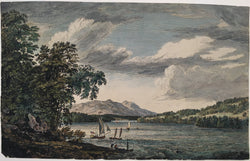![Sandby, Paul after Pownall, Thomas [A View in Hudson’s River of Pakepsey & the Catts-Kill Mountains, From Sopos Island in Hudson’s River]](http://philaprintshop.com/cdn/shop/files/sandbyhudsonriver_{width}x.jpg?v=1705174068)
Paul Sandby after Thomas Pownall. [A View in Hudson’s River of Pakepsey & the Catts-Kill Mountains, From Sopos Island in Hudson’s River]. Esopus Island. From Scenographia Americana.
London, [1761-68]. 11 1/4 x 19 1/2 (sheet). Painted and engraved by Paul Sandby. Line engraving with hand color. Margins trimmed to image and just into image upper right hand side. Old tape and repairs on back. Bottom left hand corner image chipped. Else, fine good condition. Cf. Deak: 106. Cresswell, Amer. Rev., 558.
Thomas Pownall, born in England in 1722, served in North America in various official positions between 1753 and 1760, including Governor of Massachusetts and South Carolina. During this time, Pownall traveled about the colonies, keeping a journal and making sketches of the sites he visited. Upon his return to England, Pownall hired Paul Sandby, the drawing master at the Royal Military Academy at Woolwich, England, to work with him on producing a set of engraved scenes based upon Pownall’s sketches. This set was entitled Six Remarkable Views in the Provinces of New-York, New Jersey, and Pennsylvania in North America, and it was first published in 1761. In 1768 these prints were incorporated into Scenographia Americana, a portfolio containing twenty-eight prints by Pownall and other artists. The engraving of the prints in these series is superb, with texture, lighting, and motion all conveyed with remarkable vividness.
This print was issued in this series and shows the area near Poughkeepsie looking from Esopus Island which is half way between Hyde Park and Staatsburg today. The landscape is archetypical of the potential bounty of the continent which the British had fought for in the just ended French and Indian Wars and which they were soon to lose in the Revolution. Pownall was a strong supporter of the argument that the American colonies were of such potential that the British should do everything possible to keep them within the British empire. This is an excellent example of Pownall’s point, a strong symbol of wealth and potential in the “New World.”

